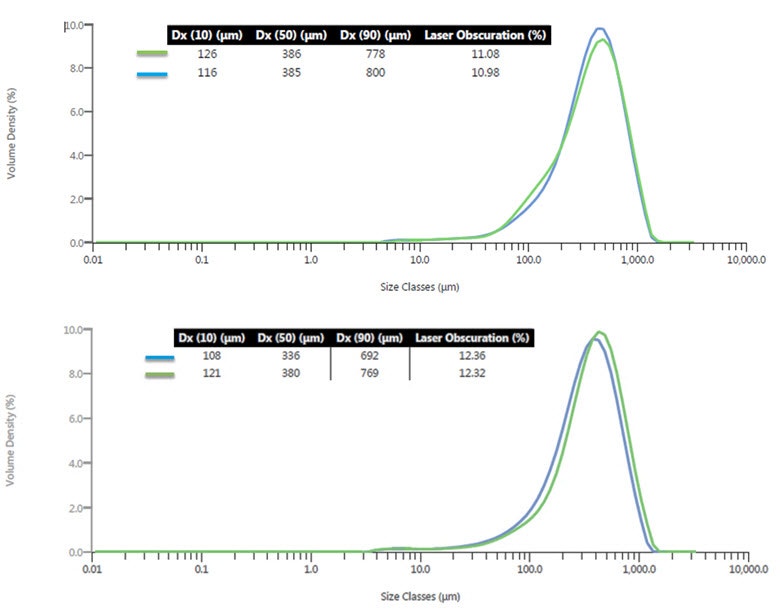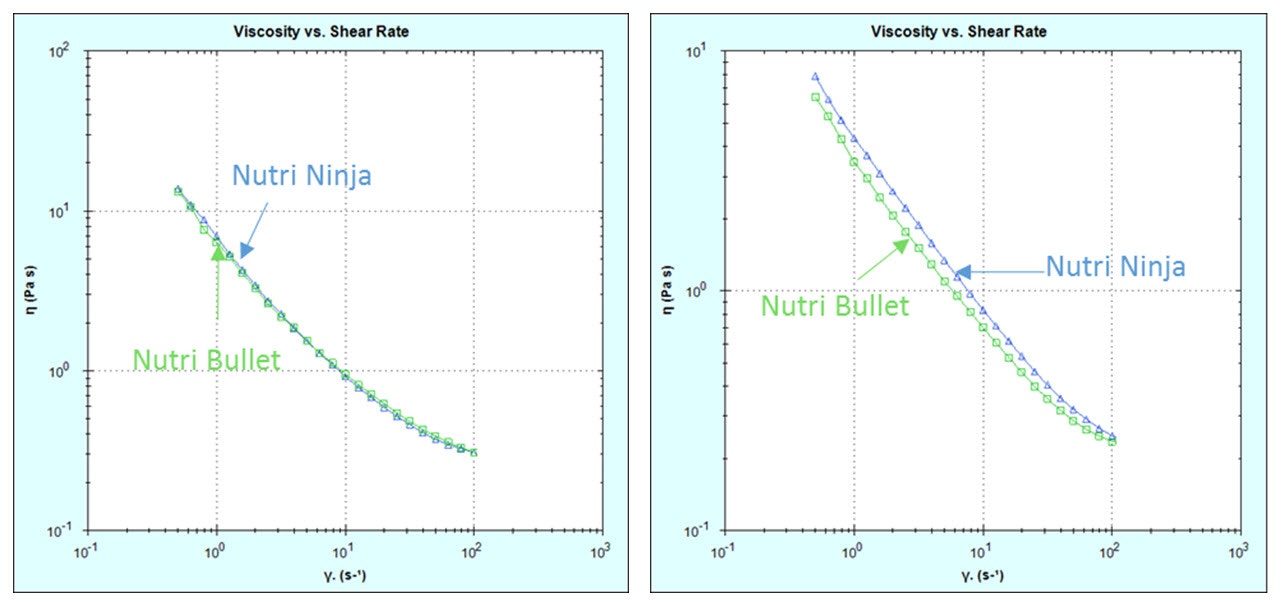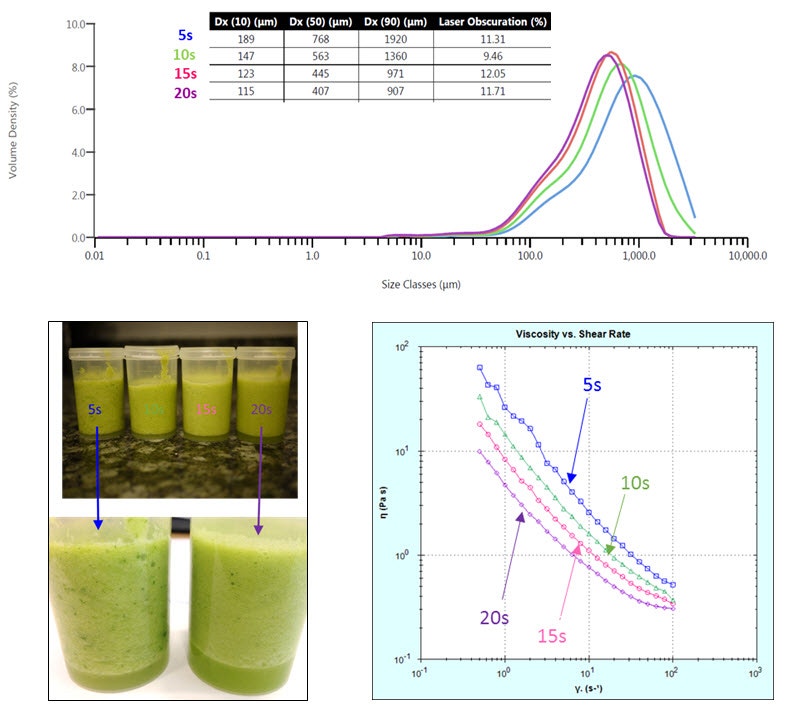Smoothies have been around for the best part of a century although it was not until the development, commercialization and evolution of the blender between 1920 and 1950 that home-made smoothies (in the modern sense) became possible. Their popularity was further accelerated by the health food movement of the 1960s and more recently the commercialization of dedicated smoothie makers such as the NutriBullet and Nutri Ninja combined with a trend towards natural and nutritious foods have revolutionized the industry.
In the Oxford English dictionary, a smoothie is defined as ‘a smooth, thick drink made with puréed fresh fruit and yogurt, ice cream, or milk’. However, there does not seem to be any fixed rules to what should go into a smoothie with common additions being vegetables, crushed ice, nuts, seeds and extra juice or water.
What is widely accepted is that a smoothie should be as smooth and easy to consume as possible, aspects which are dependent on the particle size of the blended components and the viscosity of the dispersion. While the viscosity of the blend can be controlled most easily by the choice of ingredients and amount of water used, the particle size of a given set of blended ingredients is directly dependent on the performance of the blender. This is often the main criteria that consumers will use to judge the quality of a product – the taste test.
In this study, two smoothie makers have been investigated and compared - the Nutri Ninja Pro and the NutriBullet - by measuring the particle (fibre) size and viscosity of two different recipes made with the different blenders.
Please login or register for free to read more.
Smoothies have been around for the best part of a century although it was not until the development, commercialization and evolution of the blender between 1920 and 1950 that home-made smoothies (in the modern sense) became possible. Their popularity was further accelerated by the health food movement of the 1960s and more recently the commercialization of dedicated smoothie makers such as the NutriBullet and Nutri Ninja combined with a trend towards natural and nutritious foods have revolutionized the industry.
In the Oxford English dictionary, a smoothie is defined as ‘a smooth, thick drink made with puréed fresh fruit and yogurt, ice cream, or milk’. However, there does not seem to be any fixed rules to what should go into a smoothie with common additions being vegetables, crushed ice, nuts, seeds, and extra juice or water.
What is widely accepted is that a smoothie should be as smooth and easy to consume as possible, aspects which are dependent on the particle size of the blended components and the viscosity of the dispersion. While the viscosity of the blend can be controlled most easily by the choice of ingredients and amount of water used, the particle size of a given set of blended ingredients is directly dependent on the performance of the blender. This is often the main criteria that consumers will use to judge the quality of a product – the taste test.
In this study, two smoothie makers have been investigated and compared - the Nutri Ninja Pro and the NutriBullet - by measuring the particle (fiber) size and viscosity of two different recipes made with the different blenders.
Two different smoothies were prepared and analyzed in this study; a pink and a green smoothie with the following compositions.
Green smoothie
Pink smoothie
The ingredients were blended together for 30 seconds using the Nutribullet and Nutri Ninja Pro (both 900w power rating). After blending, it was clear the smoothies were separating rather rapidly due to the buoyancy of the pulp fibres in the juice. Therefore, to measure their viscosities as accurately as possible it was necessary to keep the fibres dispersed and the sample as uniform as possible during the measurement. This was achieved using a dispersion tool (or mixer) coupled to a Kinexus rotational rheometer and a standard lower cup as shown in Figure 1.

Figure 1 – Photographs showing Kinexus mixing geometry (left), green smoothie displaying separation (middle) and Kinexus with cup and mixer configuration
Furthermore, by employing a unique method for calculating shear stress and shear rate values for non-standard measuring systems such as mixers the viscosity-shear rate profiles for the two smoothies could be reported. The particle size was measured using the Mastersizer 3000 coupled to a HydroSight accessory, which allowed the sample to be visualized while measuring the size of the pulp.
Particle size results for the two smoothies and two blenders are shown in Figure 2. The green smoothie gave a very similar particle size distribution for both smoothie makers with the Nutri Ninja giving a median pulp diameter of 386 µm compared with 385 µm for the NutriBullet. For the pink smoothie, the Nutri Ninja produced a slightly smoother drink with a median particle size of 336 µm compared with 380 µm for the NutriBullet.

Figure 2 - Particle size results for green smoothie blends (top) and pink smoothie blends (bottom) made with Nutri Ninja and NutriBullet
Figure 3 shows viscosity profiles for the different blends as a function of shear rate. Both smoothies showed shear thinning behaviour, as would be expected for a complex and concentrated dispersion of this type. For the green smoothie the flow curves were almost identical, an observation that correlated with particle size results which were similar for both blenders. Particle size and size distribution are the only real variables that would be expected to affect the viscosity since the ingredients and processing conditions were the same for both blends.
For the pink smoothie, the Nutri Ninja produced a blend that was slightly higher in viscosity than that produced with the NutriBullet which is likely due to the difference in measured pulp size for the two blenders, with the Nutri Ninja blend having a larger ratio of smaller particles. What the HydroSight revealed was that in addition to the larger pulp fibres being present there was also a large number of micro-bubbles present, which will most likely contribute to viscosity and texture also and needs to be considered.

Figure 3 – Viscosity vs shear rate curves for the green smoothie blend (left) and pink smoothie blends (right) made with Nutri Ninja and NutriBullet

Figure 4 – Particle size and viscosity data for the green smoothie measured after different blending times with the Nutribullet.
Finally, using just one blender, the differences in viscosity and particle size as a function of blending time were evaluated as shown in Figure x. Increasing the blending time resulted in a reduction in particle size (and most likely an increase in the amount of free water), which corresponded with a decrease in viscosity. After 5 seconds of blending, the smoothies were extremely lumpy requiring greater force to mix and resulting in a higher measured viscosity.
The History of Smoothies: What Every Serious Smoothie Maker Should Know – Ryan Carmody
Blending with the boss – Applied science and recipes
JJ Duffy, AJ Hill, SH Murphy; Simple method for determining stress and strain constants for non-standard measuring systems on a rotational rheometer , Appl. Rheol. 25:4 (2015) 42670